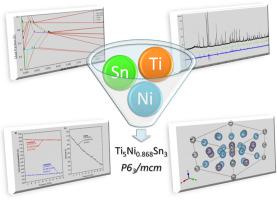当前位置:
X-MOL 学术
›
Solid State Sci.
›
论文详情
Our official English website, www.x-mol.net, welcomes your
feedback! (Note: you will need to create a separate account there.)
Evidence of an ordered ternary phase in the section Ni–Ti5Sn3 of the ternary Ti–Ni–Sn: Crystal structure and phase stability
Solid State Sciences ( IF 3.4 ) Pub Date : 2020-11-01 , DOI: 10.1016/j.solidstatesciences.2020.106349 Jean-Claude Tedenac , Pascal G. Yot , Marina Bulanova , Julia Fartushna , Catherine Colinet
Solid State Sciences ( IF 3.4 ) Pub Date : 2020-11-01 , DOI: 10.1016/j.solidstatesciences.2020.106349 Jean-Claude Tedenac , Pascal G. Yot , Marina Bulanova , Julia Fartushna , Catherine Colinet

|
Abstract In this paper we present the synchrotron and laboratory X-ray powder diffraction (S-XRPD) experiments made at normal conditions and also at different pressures (up to 2 GPa). Then crystal structure and equation of state (EoS) have been determined. These results are discussed together with experimental phase diagram. The binary phases of the Sn–Ti (Ti3Sn, Ti2Sn, Ti5Sn3) are often extended by a ternary addition. This was observed by us many times particularly in the Ga-Sn-Ti system where a ternary phase is observed. In the case of the Ni–Sn–Ti system, the question is still pending. Focusing on D88–Sn3Ti5 let remind that this phase is hexagonal, hP16, P63/mcm, prototype Mn5Si3. The point defect formation energies were obtained from first principles calculations. Four sublattices are introduced to account for the D88 structure and for the possibility of inserting atoms in the 2b sites of the structure P63/mcm. The 2b sites are not occupied in the stoichiometric compound at T 1⁄4 0 K. But the possibility exists that a few atoms occupy these sites at higher temperature or for off-stoichiometric alloys. For stoichiometric D88–Sn3Ti5 alloys, it was shown that the dominant thermal defects are composed of Sn atoms in interstitial positions 2b of the D88 structure and Ti atoms in antisite position on the sites preferentially occupied by Sn atoms. In the Sn-rich D88–Sn3Ti5, the constitutional defects are Sn atoms in interstitial positions. In the Ti-rich D88–Sn3Ti5, the constitutional defects are Ti atoms in antisite position. The chemical potentials as well as the Gibbs energy are obtained as function of composition for various temperatures.
中文翻译:

三元 Ti-Ni-Sn 的 Ni-Ti5Sn3 部分中有序三元相的证据:晶体结构和相稳定性
摘要 在本文中,我们介绍了在正常条件和不同压力(高达 2 GPa)下进行的同步加速器和实验室 X 射线粉末衍射 (S-XRPD) 实验。然后确定了晶体结构和状态方程(EoS)。这些结果与实验相图一起讨论。Sn-Ti 的二元相(Ti3Sn、Ti2Sn、Ti5Sn3)通常通过三元添加来扩展。我们多次观察到这一点,特别是在观察到三元相的 Ga-Sn-Ti 系统中。在 Ni-Sn-Ti 系统的情况下,这个问题仍然悬而未决。关注 D88–Sn3Ti5 让我们提醒一下,这个阶段是六边形的,hP16,P63/mcm,原型 Mn5Si3。点缺陷形成能量是从第一性原理计算中获得的。引入了四个亚晶格来解释 D88 结构和在结构 P63/mcm 的 2b 位点插入原子的可能性。2b 位点在 T 1⁄4 0 K 时未被化学计量化合物占据。但在较高温度或非化学计量合金中,少数原子占据这些位点的可能性存在。对于化学计量的 D88-Sn3Ti5 合金,表明主要的热缺陷由 D88 结构间隙位置 2b 的 Sn 原子和反位位置的 Ti 原子组成,该位置优先被 Sn 原子占据。在富含 Sn 的 D88-Sn3Ti5 中,结构缺陷是间隙位置的 Sn 原子。在富含 Ti 的 D88-Sn3Ti5 中,结构缺陷是反位位置的 Ti 原子。
更新日期:2020-11-01
中文翻译:

三元 Ti-Ni-Sn 的 Ni-Ti5Sn3 部分中有序三元相的证据:晶体结构和相稳定性
摘要 在本文中,我们介绍了在正常条件和不同压力(高达 2 GPa)下进行的同步加速器和实验室 X 射线粉末衍射 (S-XRPD) 实验。然后确定了晶体结构和状态方程(EoS)。这些结果与实验相图一起讨论。Sn-Ti 的二元相(Ti3Sn、Ti2Sn、Ti5Sn3)通常通过三元添加来扩展。我们多次观察到这一点,特别是在观察到三元相的 Ga-Sn-Ti 系统中。在 Ni-Sn-Ti 系统的情况下,这个问题仍然悬而未决。关注 D88–Sn3Ti5 让我们提醒一下,这个阶段是六边形的,hP16,P63/mcm,原型 Mn5Si3。点缺陷形成能量是从第一性原理计算中获得的。引入了四个亚晶格来解释 D88 结构和在结构 P63/mcm 的 2b 位点插入原子的可能性。2b 位点在 T 1⁄4 0 K 时未被化学计量化合物占据。但在较高温度或非化学计量合金中,少数原子占据这些位点的可能性存在。对于化学计量的 D88-Sn3Ti5 合金,表明主要的热缺陷由 D88 结构间隙位置 2b 的 Sn 原子和反位位置的 Ti 原子组成,该位置优先被 Sn 原子占据。在富含 Sn 的 D88-Sn3Ti5 中,结构缺陷是间隙位置的 Sn 原子。在富含 Ti 的 D88-Sn3Ti5 中,结构缺陷是反位位置的 Ti 原子。











































 京公网安备 11010802027423号
京公网安备 11010802027423号